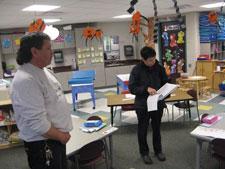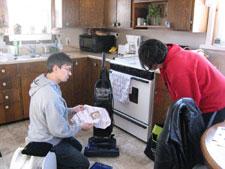Spotlight on the Tribal Indoor Air Quality Summit Workgroup in Midwest Region 5
Program Champion
Fayette Bright, EPA Region 5 Representative
For Fayette Bright, making a difference in our environment starts with air quality.
”I believe air quality is one of our most pressing environmental issues – it has a huge effect on our health. Unlike some environmental pollutants, we can’t avoid being exposed to what’s in our air. That’s why taking action now to improve indoor and outdoor air quality is so important. The Summit Workgroup has been a great opportunity to connect with tribes in Region 5 and support them in their efforts to manage indoor air quality.”
Program Summary
Momentum for a community based Tribal Indoor Air Initiative started with increased requests to EPA’s Region 5 office for assistance on a variety of indoor air issues. Community outreach efforts took root, and in 2009 EPA awarded a small grant to Bois Forte Band of Chippewa in Minnesota to plan and coordinate the region’s first Tribal Indoor Air Quality Summit. With a majority of the Region 5 tribes in attendance, the Summit generated enthusiasm for continued partnership. As a result, attendees formed the Tribal IAQ Summit Workgroup, a forum for regular collaboration based on the outcomes and goals from the Summit. Today, they continue to work together to increase their collective results.
Program Profile
Number of tribes participating: 20-25
Partnerships: U.S. Department of Housing and Urban Development, Indian Health Services, State Department of Health indoor air representatives, Eastern/Woodlands Office of Native American Programs, U.S. Department of Agriculture, American Lung Association of Minnesota
Summit Workgroup Results:
- Collaborated and increased asthma outreach activities during National World Asthma Day and National Asthma Awareness Month.
- Led IAQ Tools for Schools walkthroughs of tribal schools in Region 5.
- Read more about IAQ Tools for Schools
Key Strategies
At the Tribal IAQ Summit, titled “Get Involved and Take Action”, participants identified a need to expand collaborations in order to achieve improved results. They knew that regular interaction would help start new collaborations and help maintain existing ones, so they identified a quarterly schedule for conference calls to check-in on progress, assess results and to stay focused on the goals outlined at the Summit. Responding to the desire and vision for collaboration that participants expressed at the Summit was central to the Summit Workgroup’s formation and continued success.

IAQ Summit Workgroup participants conduct a walkthrough of a school in partnership with the Minnesota Department of Health.

A member of the Summit Workgroup educates a homeowner about a new HEPA vacuum filter during a home visit.
Build on Your Efforts:
At the Tribal IAQ Summit, titled “Get Involved and Take Action”, participants identified a need to expand collaborations in order to achieve improved results. They knew that regular interaction would help start new collaborations and help maintain existing ones, so they identified a quarterly schedule for conference calls to check-in on progress, assess results and to stay focused on the goals outlined at the Summit. Responding to the desire and vision for collaboration that participants expressed at the Summit was central to the Summit Workgroup’s formation and continued success.
Bring All Stakeholders to the Table:
Broad participation in the Summit Tribal Workgroup from Region 5 has proven there is strength in numbers. Having all tribes in the region working toward the same goals increases the Summit Workgroup’s credibility and gives its programs new importance in the eyes of tribal communities. The Workgroup forged external partnerships with EPA, the U.S. Department of Agriculture, the U.S. Department of Housing and Urban Development, and other federal, state and local not-for-profits with similar goals and missions. These partnerships serve to enrich the Summit Workgroup, adding expert knowledge that increases the impact of the Workgroup’s efforts in tribal communities.
Engage Stakeholders Regularly:
By engaging stakeholders in regularly scheduled Tribal IAQ Summit Workgroup conference calls, participating tribes are able to set and monitor benchmarks to achieve their goals. These quarterly meetings enable participants to keep indoor air quality initiatives at the forefront of their work.
Empower Others to Lead:
The Tribal IAQ Summit Workgroup strengthens tribal participants’ impact in their communities. It gives them the skills and resources they need to set goals and design programs that are specific to their own community. And, as a Workgroup, participants have access to opportunities that they would not have individually. For example, the Workgroup coordinated with EPA to obtain scholarships for Workgroup members to attend the National Asthma Forum and the IAQ Tools for Schools National Symposium in Washington, D.C. These opportunities strengthen the indoor air quality expertise among Workgroup members, a value that will be shared among all participants.
